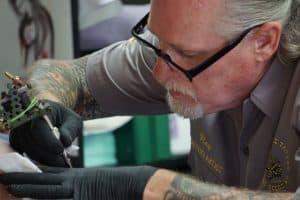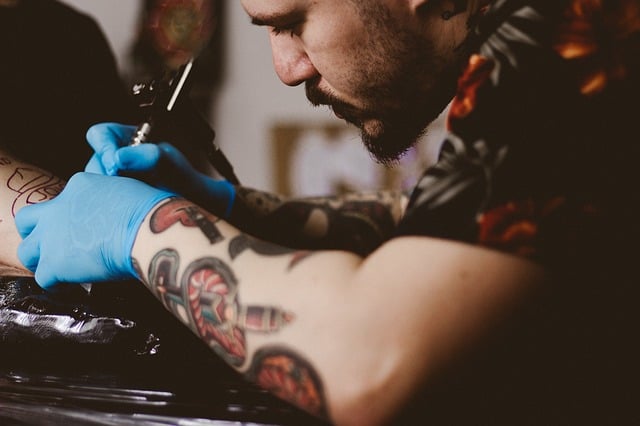So, after much thought and consideration you’re ready to pull the trigger and go big with a tattoo. You’re thinking sleeve or full back tattoo. You’ve chosen the perfect design, found a reputable tattoo artist and are ready to get started.
Even if this isn’t your first tattoo, the size and complexity of a sleeve or full back tattoo will most definitely involve a different overall experience and you may have some questions regarding exactly what is involved. How long will it take? How many hours can I sit for one session? Can I do consecutive sessions? What can I do to help me pass the time (and take my mind off the pain)?
We’ve got the answers you’re looking for in the article below.
How Long Does it Take to Complete the Tattoo?
There is no single right answer to this question as there are multiple variables involved. These include:
- The speed of your tattoo artist
- Complexity of the design
- How many colors used
- Location on your body
- Your pain tolerance
- How long you can sit still
- Your tattoo artist’s personal limits
- Your healing time between sessions
These are just some of the variables that will come into play. The single biggest factor is the size and complexity of the design. While a full sleeve or back tattoo that is a simple design can take as little as 10 – 15 hours, a more complex design can take as much as 50 – 80 hours and involve sessions that span up to a year.
Getting a full sleeve or back tattoo is a big investment in time and money and you should be prepared for it to be an ongoing process for weeks or even months.
How Long Can I Sit Per Session
You might think you can sit for 8,10,12 hours or more. And, you might be correct. However, it is most certainly not recommended. It is generally accepted that a tolerable, average time frame for 
Your adrenaline will get you through the first few hours and the pain you’ll experience. And yes, even hardened tattoo fanatics will experience pain. After that, your reserves are going to be tapped out and you will simply run out of the steam you’ll need to continue to withstand whatever pain you may be feeling. More pain also equals more flinching which is not a good thing when getting tattooed.
Something else to consider is the fact that the longer a session takes, the more inflamed your skin will become and the more you will bleed. This can impact the artist’s ability to tattoo effectively.
Ever notice how, after a while of doing the same of any activity, no matter how passionate you are about it, you begin to lose some of that initial excitement and ‘freshness’ that you began with? Your tattoo artist also has their own limits as to how long they can work before needing to recharge and change focus. Listen to their suggested time frame for each session — they know what’s best for you and them.
How Long Do I Have to Wait Between Sessions
It is generally considered safe and advisable to wait a minimum of two to three weeks between tattoo sessions, and there are multiple reasons for this.
During this time frame, your tattoo will scab and peel and then appear healed. However, this is only on the surface. Below the tattoo, the deeper layers of skin will still be healing. The longer you wait, the more healing time you are giving your body to be fully up and running for your next session.
Anytime you are actively healing a wound — which is what a tattoo is — your body is at a greater risk of illness and infection. The sooner you sit for another session, the greater your risk of infection, and an infection means more healing time.

Another consideration is your pain threshold. While getting the tattoo is painful, healing can also cause discomfort in the form of tenderness, swelling, and itching, along with aches and pains that may impact your everyday activities. It’s imperative that you give your body time to heal before going under the needle again.
Best Ways to Pass The Time
Sitting still for hours, while in some amount of pain and discomfort, is difficult. There are things you can do to help pass the time and take your mind off of the pain.
- Make a new playlist, pop in those earbuds and escape into your music. Just remember, no air guitar or drum solos.
- Bring an iPad, phone or other device on which you can watch a movie or television show — the funnier the better to help you ignore the pain.
- Download several episodes of your favorite podcast.
- Bring a friend to talk to.
- Talk with the artist, if they are willing and can maintain their focus and concentration.
- Avoid handheld games, and lots of phone activity (texting, talking). These can cause you to move more than you might be aware and can distract the artist.
Final Do’s and Don’ts
Do’s
- Avoid alcohol the night before; alcohol is a blood thinner which can mean excess bleeding
- Eat a good meal before your session and bring snacks. You will be there for hours — you don’t want to add hunger pains to your discomfort. Also, becoming lightheaded and fainting due to low blood sugar is not good during a tattoo session.
- If you have more than a little peach fuzz where the tattoo is going, shave, exfoliate and lather on the lotion before your session. The smoother the surface for your artist, the better.
- Stay hydrated with water and bring extra.
- Breathe. Sounds obvious, but we tend to hold our breaths when experiencing pain. Keep breathing. It helps you stay calm and still, helps deal with the pain, and you won’t get lightheaded or pass out from lack of oxygen.
- Bring a jacket, socks, gloves, and a warm hat. Depending on where you’re getting tattooed, you may have a lot of skin exposed. What you don’t want to happen is that you get cold and start shivering.
- Communicate. If anything feels wrong, speak up. If you prefer a certain sitting position, tell your artist. It benefits both of you when you’re as comfortable and relaxed as possible.
- Tell your artist when you need a break. A break from the pain. A stretch break. A food break. They could probably also use it.
Don’ts
- Be drunk or high. You can bleed more and you also won’t sit still.
- Walk into a tattoo shop without knowing about the shop and the artist. Do your research. Check out portfolios. Make sure it’s clean.
- Haggle pricing or price shop. It’s going to be on your body forever. It’s Neiman Marcus, not Dollar Store, time.
- Have no idea what tattoo you want to get. Artists will work with any ideas, pictures, sketches, stick drawings you have. Just have something. Along these same lines, do not listen too much to other’s opinions. Make sure you get something you love.
- Have a tight schedule. Your tattoo artist is just that — an artist — and shouldn’t be rushed.
- Forget to shower and brush your teeth. You and your tattoo artist will be in close proximity for an extended period of time. Don’t make them hold their breath.
- Wiggle. Don’t talk with your hands, play with your phone, etc. Find your om and be still.
- Bringing one friend — fine. Don’t bring your whole gang. It takes up space and is distracting.
- Blow off your aftercare. Listen to your artist’s care instructions and follow them if you want your tattoo to look great and last.
- Forget to tip. Much like hair stylists and masseurs, your artist likely has to give a hefty chunk of their fee to the shop they work in, so the standard 15 – 20% tip is important.
- Show up for your appointment with an injury. Your body needs all its healing strength for your tattoo. Competing with another injury could affect your healing.
- No heavy weight lifting two days prior to sitting for your session. Being ‘swole’ is great — unless you’re getting a tattoo.
Committing to any tattoo should be something you take seriously. Committing to a sleeve or full back tattoo takes even more consideration, time, thought, and planning. In the end, you hope for a stunning piece of artwork you’ll always be proud to wear.

